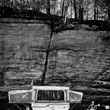It’s a short distance from the trailhead to the lake, but it’s a bitch of a hike. A straight-up thigh-buster. But at least you’re out of the damn truck and relieved to discover no permanent damage to your “jiggly parts.” The hike, believe it or not, is the easiest part of getting here. No matter how you try to sugarcoat it, you’re two hours off the pavement and well into the sticks by the time you make that final uphill push into the “pine” portion of the Pine Forest Range of northern Nevada. Even when you guide your truck over the last of the rocks that have likely pierced many an oil pan over the years, and settle on a place to leave the truck in the “parking lot,” you’re still in the desert. And you’re a long way from anything.
Naturally, you look up the trail, where, rumor has it, there lies a chain of lakes so full of spunky trout that the water is just one big rise ring when the evening hatch comes off. But the real surprise is the look back down the mountain from whence you came. The desert is unassuming when you’re driving through it, dodging wild burro turds and keeping your eye on that green crotch in the mountains high above where these lakes supposedly sit. There, you think, it’s cooler, and the greenery proves it. Mountain mahogany, limber pine and aspen won’t grow without water, and they sure as hell won’t grow down here, where even the sage looks depressed and downtrodden.
When you finally get close enough to get out and walk, it’s just not natural to turn around and check out the road you just traveled. But the vista will take your breath away, just the same. From up here, the desert is vast and foreboding. It’s huge. Its muted colors of all things drab and boring mix together in a palette so stunning that you forget about the scrawny jackrabbits and the pronghorns that looked so forlorn you were tempted to get out of the truck and try to feed them by hand.
It’s surreal.
Your gaze is pulled to the horizon—is that California clear in the crystal-clear distance? You think so.
More Like This
Then reality. You didn’t just bounce your $40,000 rig over all those rocks to admire the view of the desert below. You’re here to fish, no matter how fishless this place feels in your gut. Trout? Here? No way.
But you’re game. And, hell, you’re here, right? After that cheap-ass carnival ride, sans the barf bag, just stretching some fly line will feel mighty good, even if there are no fish to target. Surely there can’t be fish. Not here in this dry, dusty, God-forsaken corner of the most God-forsaken state in the union.
So you start that hike, and even the burn in your thighs is a welcome respite from the bouncing and the rocking and the dust. And then, suddenly, it’s cooler. There’s shade thanks to some hearty aspens that hang on stubbornly in this desolate land. It feels nice to be out of the sun, out from under that so-blue sky. And it smells good. Sweet. Cool. It smells like … well, it sure as hell doesn’t smell like the desert. The trail guides you up a bit higher, and you punch through the aspen thicket and reach the top of a bluff. It’s a good place to rest, to reevaluate.
Before you looms the sheer face of a mountain, nude thanks to its rocky contents. A long talus moraine skirts the rock and disappears below the tops of some trees in the distance. There, you think, lie the lakes. If there are, indeed, lakes. It could be a cruel joke, right? The rest of the gang, suspiciously slow to assemble their packs and gather their gear, could be sitting on the tailgate sucking down PBR and laughing their asses off at the idiot who just wandered off into the desert with a fly rod.
Do you turn back? Do you admit your deepest fear, that you’ve spent two days venturing to this distant place only to find it barren and fishless? You push on. It can’t be that much farther, right?
The trail, mercifully, starts down, and soon, you’re back among the quakies, enjoying that fresh, coolness that comes over you like a Friday night drunk. The golden leaves remind you that, no matter how hot it was when you stopped to take a leak and chase a wild burrow just for kicks down on the desert floor, the calendar has turned over to early October, and it’s full-on fall up here at altitude.
Minutes later, off in the distance, you see it. Standing water. And not just a puddle or high-elevation cirque. It’s a lake. Wait. It’s two lakes. And what’s that? Is that a rise ring? Another?
Your step quickens and your thoughts switch from dire and hopeless to something resembling optimism. But you’re not there yet. At this elevation, the source of that rise could be a six-inch brookie for all you know. I mean, an hour ago, you were coughing up road dust and hydrating with cheap beer. No sense getting your expectations up, right?
But it was a rise ring. You’re sure of it.
The trail leads into a draw and the lake disappears, hidden from view by the bright leaves of the aspens that filter the sunlight and leave you walking through a forest rife with color so deep and intense that you struggle to come up with a description for the hue.
Your heartbeat quickens. Are the lakes really there, off in the distance? Or was the vision from atop the bluff a desert-induced mirage that’s taking advantage of your fishy senses? The trail continues through the trees as if it might never emerge, teasing you with the promise of long casts across green water to rising fish. It was a mirage. Right?
The trees thin out a bit and then your nose catches that familiar scent… that slightly pungent tang of water standing under sunlight. Maybe, just maybe …
You step through the threshold of the trees and the horizon opens before you. The soft sound of water licking rock awakens a primal urge deep in your soul and you gaze off over a deep, green lake that literally glistens in the afternoon sunshine. You hear a gulp. Then another. A head the size of Granny Smith apple emerges from the lake, mouth open to ensnare some unseen bug stuck in the surface film. Gulp.
You drop your pack where you stand, and you fumble around clumsily for your rod tube. It takes what seems like an eternity to slip four simple pieces of graphite together, and you feel a palsy come over you as you attach the reel and begin threading a loop of fly line through the guides. Another gulp. You fumble the line and the shakes set in with a vengeance.
Here, high atop the stark Nevada desert, you find yourself in a nervous funk, worried that, for some reason, that hatch that is bringing these gulping fish to the top of this cool, green lake might end before you can make that first cast. Your gaze is torn between ensuring you string line through every guide on your rod and watching for the next behemoth to surface on this lake, much like a humpback whale might breach in the north Pacific.
Line threaded, now your shaky hands must find the dexterity to tie a fly to your tippet. First things first, though. You look at the glassy surface of this lake, hoping to find the insect that is spurring such careless takes among the lake’s massive trout. Through polarized lenses your eyes catch a large, gray mayfly struggling in the surface film not a dozen feet from shore. Then it disappears in a swirl of teeth and mottled, golden-green scales.
Tiger trout. A laboratory creation, a twisted mix between a brook trout and a brown trout … a sterile, unnatural “salmo on salvo” combination that has curried favor among fisheries managers, both for sport and for ridding waters of so-called “rough fish.” These fish eat and they do little else.
Glancing around at the high rocks surrounding this backcountry lake, you immediately envy the ride the helicopter pilot enjoyed the day he dumped these Frankenfish into the water for the benefit of someone like you, who bounced and rumbled over barely passable roads for hours, sucked in the powdery dust churned up by the thick, black tires of the truck and walked another mile through aspens and uncertainty.
Now, before you, they gulped big mayflies, taunting you, teasing you, tempting you.
You choose a fluffy Parachute Adams for this task, and, trembling hands and all, you manage to tie it tight to your tippet. You look around for a reasonable casting location, one that won’t end with your fly snared permanently by the clingy branches of a lakeside limber pine.
There, a dozen feet off the bank, you see a large, flat rock just a few inches under the surface. Minutes later, after a half-wade, half swim through the autumn-chilled lake, you’re standing on that rock and you’re peeling line from your reel. Your fly, doused with floatant, is pinched between your forefinger and thumb, and you scan the water, waiting for the next rise.
Then, 40 feet out, you spy a nose. Flipping the fly in the air, you start a calculated backcast and with a deft, practice stroke, you lay the Adams in the center of the expanding rise ring. The fly rests lightly on the water. You give it a slight twitch.
Gulp.






























Comments